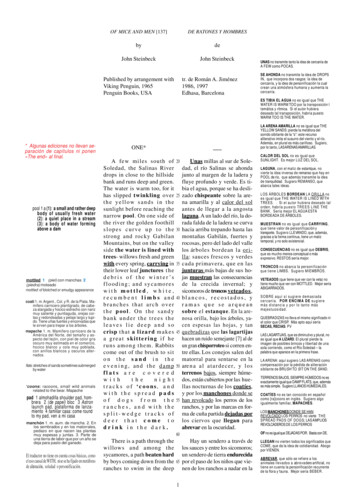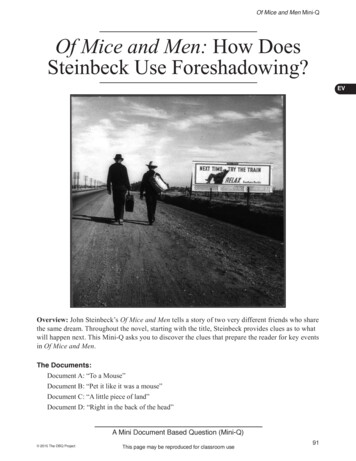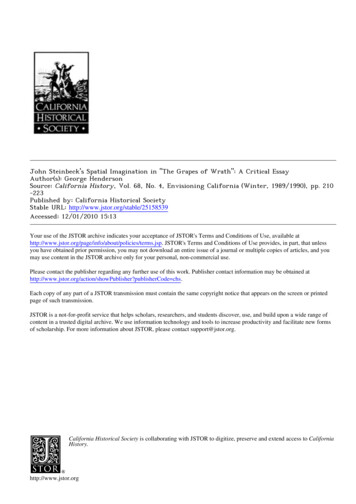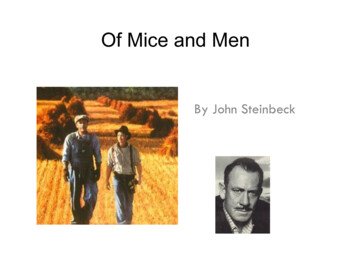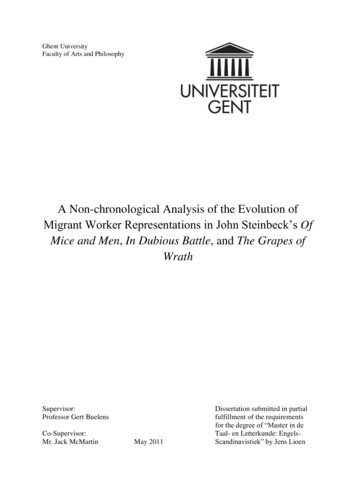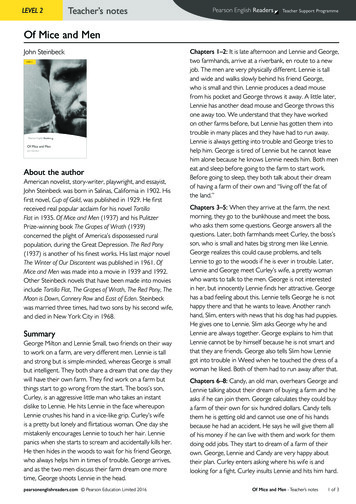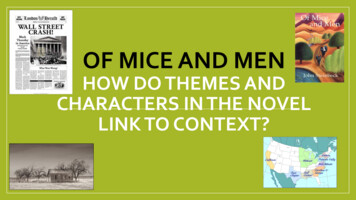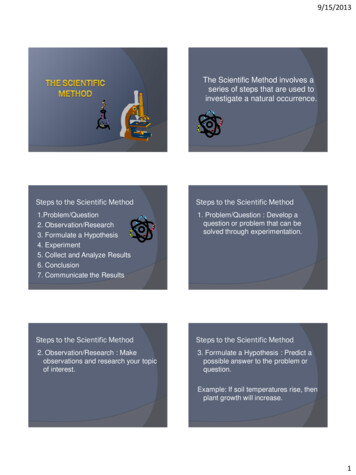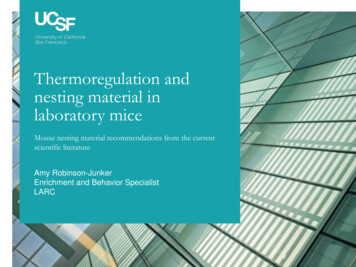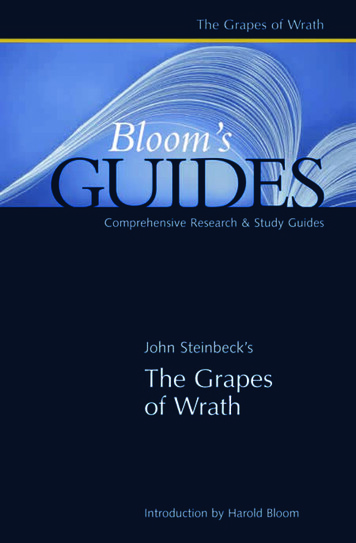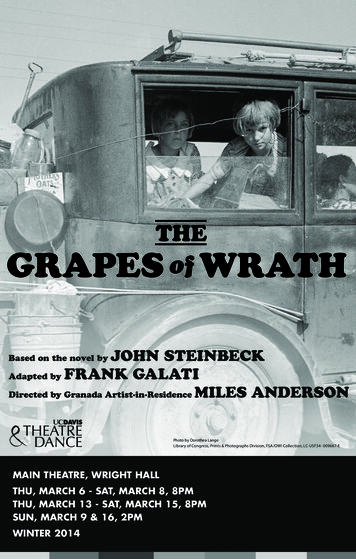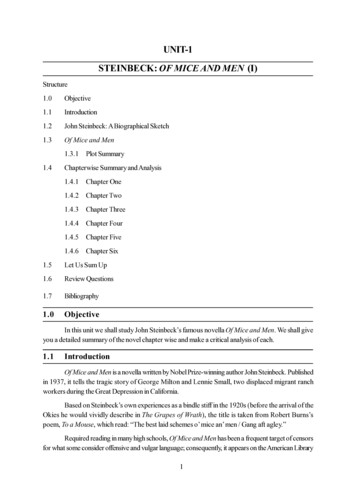
Transcription
UNIT-1STEINBECK: OF MICE AND MEN (I)Structure1.0Objective1.1Introduction1.2John Steinbeck: A Biographical Sketch1.3Of Mice and Men1.3.1 Plot Summary1.4Chapterwise Summary and Analysis1.4.1 Chapter One1.4.2 Chapter Two1.4.3 Chapter Three1.4.4 Chapter Four1.4.5 Chapter Five1.4.6 Chapter Six1.5Let Us Sum Up1.6Review Questions1.7Bibliography1.0ObjectiveIn this unit we shall study John Steinbeck’s famous novella Of Mice and Men. We shall giveyou a detailed summary of the novel chapter wise and make a critical analysis of each.1.1IntroductionOf Mice and Men is a novella written by Nobel Prize-winning author John Steinbeck. Publishedin 1937, it tells the tragic story of George Milton and Lennie Small, two displaced migrant ranchworkers during the Great Depression in California.Based on Steinbeck’s own experiences as a bindle stiff in the 1920s (before the arrival of theOkies he would vividly describe in The Grapes of Wrath), the title is taken from Robert Burns’spoem, To a Mouse, which read: “The best laid schemes o’ mice an’ men / Gang aft agley.”Required reading in many high schools, Of Mice and Men has been a frequent target of censorsfor what some consider offensive and vulgar language; consequently, it appears on the American Library1
Association’s list of the Most Challenged Books of 21st Century.1.2John Steinbeck: A Biographical SketchJohn Steinbeck was born in Salinas, California, on February 27, 1902 of German and Irishancestry. His father, John Steinbeck, Sr., served as the County Treasurer while his mother, Olive(Hamilton) Steinbeck, a former school teacher, fostered Steinbeck’s love of reading and the writtenword. During summers he worked as a hired hand on nearby ranches, nourishing his impression of theCalifornia countryside and its people.After graduating from Salinas High School in 1919, Steinbeck attended Stanford University.Originally an English major, he pursued a program of independent study and his attendance was sporadic.During this time he worked periodically at various jobs and left Stanford permanently in 1925 topursue his writing career in New York. However, he was unsuccessful in getting any of his writingspublished and finally returned to California.His first novel, Cup of Gold was published in 1929, but attracted little attention. His twosubsequent novels, The Pastures of Heaven and To a God Unknown, were also poorly received bythe literary world.Steinbeck married his first wife, Carol Henning in 1930. They lived in Pacific Grove wheremuch of the material for Tortilla Flat and Cannery Row was gathered. Tortilla Flat (1935) markedthe turning point in Steinbeck’s literary career. It received the California Commonwealth Club’s GoldMedal for best novel by a California author. Steinbeck continued writing, relying upon extensive researchand his personal observation of the human condition for his stories. The Grapes of Wrath (1939) wonthe Pulitzer Prize.During World War II, Steinbeck was a war correspondent for the New York Herald Tribune.Some of his dispatches were later collected and made into Once There Was a War.John Steinbeck was awarded the Nobel Prize for Literature in 1962 “.for his realistic as wellas imaginative writings, distinguished by a sympathetic humor and a keen social perception.”Throughout his life John Steinbeck remained a private person who shunned publicity. He diedon December 20, 1968, in New York City and is survived by his third wife, Elaine (Scott) Steinbeckand one son, Thomas. His ashes were placed in the Garden of Memories Cemetery in Salinas.1.3Of Mice and Men1.3.1 Plot SummaryThe novel takes place in the California valley along the Salinas River. There are two settingsfor the action: the banks of the Salinas River and a nearby ranch. George Milton, small and smart, andhis friend Lennie Small, a large man with mild retardation, are on their way to jobs at a ranch. Theystop by the Salinas River to take a break from their long walk.Lennie cannot remember where they are going, and George, annoyed, reminds him about theirjobs. Lennie looks in his pocket for his work card and finds a dead mouse, which he found by the side2
of the road. Lennie likes to pet soft animals, like mice and puppies, but he is very strong and often killshis delicate pets. Lennie tries to hide his mouse from George, who demands it from him and throws itacross the river.That evening, Lennie goes to find his mouse, which makes George very angry. He argues withLennie, but soon feels bad and tries to console him. George tells Lennie how one day soon they willown a farm of their own, where they will grow their own food and have rabbits Lennie can tend.The next morning Lennie and George arrive at the ranch. The boss is annoyed because theyhave arrived late. The boss’ son, Curley, is a small man who hates big guys like Lennie. He and Georgehave a small confrontation. Soon after Curley leaves his wife enters. Her provocative dress and posemake George anxious. He warns Lennie to keep away from both Curley and his wife.Two more workers, Slim and Carlson, come into the bunkhouse. Slim’s dog just had puppies,and Lennie is anxious to have something soft to pet. Carlson suggests that Candy, an old man andfellow worker, kill his old smelly sheepdog and take one of Slim’s pups.Slim gives Lennie a pup, and he spends much of the evening out in the barn petting it. Georgetells Slim what happened at their last job. They were run out of town after Lennie unintentionallyassaulted a woman. The woman went to the police and Lennie and George had to leave town.Candy comes in with his dog and Carlson starts pressuring him to let him kill it. The dog is oldand arthritic, but Candy has had him for years. Since he is the only one who wants to keep the dog,Candy reluctantly gives in and lets Carlson shoot his old friend.George and Lennie start talking again about the farm they hope to get, and Candy overhearsand asks if he could come too. He has some money saved up, so George decides he can come. Curleycomes into to the bunkhouse, and when he sees a smile on Lennie’s face he imagines that Lennie islaughing at him. He attacks Lennie, who doesn’t want to fight. In defense, Lennie grabs Curley’s handand badly breaks it without knowing what he has done.That evening, everyone goes into town, except for Crooks, the crippled Negro stable buck,and Candy, Lennie, and Curley’s wife. Crooks lives alone in the barn because he’s black. Lenniecomes in looking for his puppy. He and Crooks start talking, and Crooks expresses his feelings ofloneliness. Lennie tells Crooks about their farm, but Crooks is doubtful. After listening to Candy for afew minutes, Crooks changes his mind and asks if there might be a place for him on the farm.Curley’s wife comes into the barn, making all the men uncomfortable. Candy tells her to leave.She gets mad and criticizes them and their dream, making Crooks angry. She harshly reminds him heis just a worker, and a black worker at that. Crooks silently hangs his head. There is the sound of themen returning, so Curley’s wife leaves. As Candy is leaving, Crooks tells him he wouldn’t be interestedin coming with them after all.The next afternoon, Lennie is in the barn alone with his puppy. He accidentally killed it with hisstrong hands. Curley’s wife comes in, and sits down next to Lennie. She tells him how she could havebeen in the movies, but Lennie continues rambling about the rabbits on their farm. When she finds outhow much Lennie likes soft things, she offers to let him touch her hair. Lennie strokes too hard and shegets frightened. He tries to quiet her and accidentally breaks her neck. Lennie runs and hides by the3
banks of the river. Candy finds Curley’s wife, and goes to tell George. The other men come in and seewhat happened, and they get their guns. They want to find Lennie and kill him.Lennie is sitting by the banks of the river. George shows up, and he assures Lennie he isn’t madat him. Lennie wants to hear about that piece of land they are going to get, and the rabbits for him totend. George tells him, and when the men are nearly there, George shoots Lennie in the head. The menappear, and Curley and Carlson congratulate George. Slim understands George didn’t want to shootLennie, and he leads him away, offering him comfort and a drink.1.4Chapterwise Summary and Analysis1.4.1 Chapter OneGeorge and Lennie, two migrant workers during the Great Depression, walk along a trail onthe Salinas River just south of Soledad, California. They are on their way to a new ranch, where theyhope to be hired to “buck barley,” that is, to haul sacks full of grain. A bus driver recently let them outand told them the ranch was nearby. However, the walk is much longer than they anticipated.George is a small, quick man with dark, suspicious eyes. Lennie is just the opposite: a naive,unintelligent mountain of a man. As they walk along, Lennie comes upon a pool of water and drinksthirstily; George warns him that the water might be bad as it has been stagnant in the sun, but Lenniepays him no heed. After Lennie drinks his fill, George quizzes him on the upcoming job. Lennie, however,fails to remember even the slightest detail of their current prospect. George reminds him that they havereceived work cards from Murray and Ready’s.As George pats his pocket, where the work cards are kept, he notices that Lennie has somethingin his pocket as well: a dead mouse. Lennie explains that he likes to pet the mouse’s soft fur as hewalks. George takes the mouse from Lennie and throws it into the bushes. He then admonishes Lenniefor his behavior, warning him not to behave badly, as he has done so often in the past, and ordering himnot to say a word when they meet the boss at the new ranch. He reminds Lennie of past misadventures,specifically an episode in the town of Weed in which Lennie assaulted a woman in a red dress becausehe thought her dress was pretty and wanted to feel it. The woman accused Lennie of attempting to rapeher and George and Lennie had to run for their lives out of town. While recounting this incident, Georgecomplains that if he didn’t have to take care of Lennie he could live a normal life: “I could live so easyand maybe have a girl.”George tells Lennie that they are going to bivouac a couple of miles away from the ranch sothat they won’t have to work the morning shift the next day. They set up camp and George sendsLennie off to look for firewood so that they can heat up some beans. Lennie goes off into the darknessand returns in a moment; George instantly knows from Lennie’s wet feet that he has retrieved the deadmouse. He takes it from Lennie, who begins to whimper. George assures Lennie that he’ll let him pet a“fresh” mouse, just not a rotten one. They recall that Lennie’s Aunt Clara, whom Lennie refers to as “alady,” used to give Lennie mice to play with.Lennie fetches some wood and George heats up their beans. Lennie complains that they don’thave ketchup, which sets George off on a rant about having to care for Lennie. After this outburst,George feels ashamed. Lennie apologizes and George admits that he’s “been mean”. Lennie passive4
aggressively offers to go away and live in a cave so that George can have fun. George resolves thisshort argument by agreeing to Lennie’s request to “tell about the rabbits,” which is Lennie’s shorthandfor “talk about how things will be for us in the future.” George paints a picture of the future – a picturehe has obviously painted countless times before – in which he and Lennie have their own place on theirown farm and “live off the fat of the land.” He promises Lennie that they will have rabbit cages and thatLennie will be allowed to tend them. Lennie repeatedly interrupts George as he tells this story, butinsists that George finish it to the end.As they prepare to sleep, George reminds Lennie not to say a word during their interview withthe boss the following day. He also tells Lennie that if he runs into trouble, as he has so many timesbefore, he is to return to the place where they’ve camped, hide in the brush and wait for George.AnalysisJohn Steinbeck’s enduring popularity is largely the result of his ability to weave a complicatedfictional reality from simple elements – simple language, simple characters, simple techniques. One ofthe techniques he uses consistently is the juxtaposition of the human and the natural worlds. He often –as in The Grapes of Wrath – alternates short natural vignettes with the parallel struggles of humankind.Of Mice and Men, as is clear from the title alone, features this parallelism as well. It is a novel about thenatural world – “of mice” – and the social world – “and men.” The relationship between these twoworlds is not one of conflict but of comparison; he invites us to witness the similarities between thehuman and animal worlds.The title, Of Mice and Men, comes from an eighteenth-century poem by Robert Burns entitled“To a Mouse.” This poem features a couplet that has become widely known and quoted: “The bestlaid schemes of mice and men / Gang oft aglay.” That last phrase, written in Scottish dialect, translatesas “often go wrong.” As will become clear, the quotation relates directly to our two protagonists, whodo indeed have a “scheme” to get out of the cycle of poverty and alienation that is the migrant worker’slot: they plan to purchase a farm of their own and work on it themselves. Lennie visualizes this futurepossibility as near to heaven – he can imagine nothing better than life with “the rabbits.” Their action inthe novel is largely motivated by a desire to achieve the independence of this farm life.Poverty, in Burns’ work as well as Steinbeck, draws the human and the natural worlds closertogether. During the Great Depression, in which the novel is set, workers were thrust from relativecomfort to fend for themselves in a cruel and uncaring world. They face the original challenges ofnature – to feed themselves, to fight for their stake. Poverty has reduced them to animals – Lennie aponderous, powerful, imbecilic bear; George a quiet, scheming, scrappy rodent of a man. Notice howfrequently the two men, particularly Lennie, are described in animal similes: Lennie drags his feet “theway a bear drags his paws” and drinks from the pool “like a horse”. Lennie even fantasizes about livingin a cave like a bear.Of course, Lennie’s vision of nature is hardly realistic; he thinks of nature as full of fluffy andcute playthings. He has no notion of the darkness in the natural world, the competition and the cruelty.He wouldn’t have the faintest notion how to feed himself without George. In this too the men balanceeach other: George sees the world through suspicious eyes. He sees only the darkness where Lenniesees only the light. George may complain about how burdensome it is to care for Lennie, but this5
complaint seems to ring hollow: in truth, George needs Lennie’s innocence as much as Lennie needsGeorge’s experience. They compliment each other, complete each other. Together, they are more thanthe solitary and miserable nobodies making their migrant wages during the Depression. Together, theyhave hope and solidarity.George’s complaint – “Life would be so easy without Lennie” – and Lennie’s counter-complaint– “I could just live in a cave and leave George alone” – are not really sincere. They are staged, hollowthreats, like the threats of parents and children (“I’ll pull this car over right now, mister!”). Similarly,George’s story about how “things are going to be,” with rabbits and a vegetable garden and the fat ofthe land, also has a formulaic quality, like a child’s bedtime story. Children (like Lennie) love to hear thesame tale repeated countless times; even when they have the story memorized, they love to talk along,anticipating the major turns in the story and correcting their parents if they leave out any details. “Therabbits” is Lennie’s bedtime story, and while George isn’t exactly a parent to Lennie, he is neverthelessparental. George is Lennie’s guardian – and in guarding Lennie, George is in effect guarding innocenceitself.Steinbeck’s plots are as simple and finely honed as his characters. Each topic discussed - thewoman who mistakenly thought that Lennie was trying to rape her, the mice that Lennie crushes withaffection, George’s order that Lennie return to the campsite if anything goes wrong - will come intoplay in the chapters to come. Keep these details in mind as we continue.1.4.2 Chapter TwoThe following morning, George and Lennie reach the bunk house at the farm. Candy, the oldman who shows them the bunk house, tells them that his boss was expecting them the night before andwas angry when they weren’t ready for work in the morning. Near his bed George finds a can of insectpoison, which leads him to think that his bunk is infected, but the old man reassures him, telling him thatperson who had the bed before was a meticulous blacksmith named Whitey who kept the insect killeraround even though there were no insects to kill.As George prepares to meet the boss, Candy reports that he is a nice enough man although hetakes his anger out on the black stable buck, Crooks. Soon enough, the boss enters and asks Georgeand Lennie for their work slips. George attempts to speak for both Lennie and himself, but the bossnotices Lennie’s silence and questions him directly. Lennie attempts to speak for himself, aping phrasesthat George has spoken, but sounds completely ridiculous. George tells the boss that Lennie isn’tbright, but that he’s as strong as a bull and an incredibly hard worker.The boss wonders why George is willing to take care of Lennie; George tells the boss thatLennie is his cousin and that he promised his mother to look after him. When the boss wonders whythey left their last job, George tells him that they were digging a cesspool and completed the work.When the boss leaves, George scolds Lennie for failing to keep completely silent. George admits thathe lied about Lennie being his cousin.Candy returns with his old sheepdog, and George snaps at him for eavesdropping. Curley, ahaughty young man, enters the bunk looking for the boss, who is his father. He behaves threateninglytoLennie. When he leaves, Candy explains that Curley, who is short, hates big guys like Lennie out of6
jealousy. George says that however tough Curley may be, he will be sorry if he picks a fight withLennie, who is incredibly strong. Candy notes that Curley was recently married to a local beauty andthat he has become more cocky ever since. Curley wears a left glove full of Vaseline to keep the handsoft for his wife, whom the old man thinks is a tart. George warns Lennie to avoid Curley.On cue, Curley’s wife comes to the bunk house looking for her husband. She is provocativelydressed and quite flirtatious. When she leaves, George remarks that she’s a tramp, while Lennie saysthat she’s pretty. George warns him to keep away from her.Next to enter is Slim, the widely respected jerkline skinner. Slim questions George and Lennieabout what work they can do. Carlson, a large, big-stomached man, also enters the bunk house andasks Slim whether his dog had her litter last night. Slim tells him that she had nine puppies, but that hedrowned four immediately since she couldn’t feed so many. Carlson complains about the smell ofCandy’s old sheepdog and tells Slim that Candy should put it out of its misery.Curley enters again and confronts George, asking if his wife has been around. George admitsthat she was at the bunk house. Curley seems eager to start a fight with anyone.AnalysisThe novel as a whole, and this chapter in particular, shares many elements with stage drama.Steinbeck often uses a single room as a setting for a scene, as the bunk house is used here. Thistechnique allows him to introduce a wide variety of characters quickly without using a narrator - thecharacters talk about each other, interact, and even describe each other (as when Candy talks aboutCurley being a “little guy”), all of which facilitates relatively rich characterization in a relatively shortnumber of pages.This stage technique applies to Steinbeck’s descriptions as well as his dialogue. Consider thedescription of Candy’s dog at the close of the chapter: “The dog gazed about with mild, half-blindeyes. He sniffed, and then lay down and put his head between his paws etc.” Steinbeck’s language iscompletely shorn of emotion; he simply describes the animal’s actions as a playwright might write stagedirections.This “dramatic” technique gives Steinbeck’s story a portentous quality. On one level, he issimply describing an evening among itinerant workers in a realistic way; on another level, the actionsand personae of these workers take on a larger, almost mythic significance. Just as in dramatic worksof the same period - such as Thornton Wilder’s Our Town - Steinbeck blends the workaday with thehighly stylized, bringing out the eternal, allegorical character of everyday life. Thus Curley comes torepresent all petty, embittered men; Crooks stands in for the persecution and the suffering of all AfricanAmericans; George is the eternal cynic-with-a-heart-of-gold and Lennie personifies clumsy innocence.The characters are types, or even archetypes, as much as they are individuals - a technique morepopularly associated with plays and films than with literary fiction.This stage technique also allows Steinbeck to build tension quickly without exposition. Theatmosphere of Chapter Two is immediately hostile and uncomfortable: George suspects that his bed isinfested, the Boss suspects that George and Lennie are trying to pull a fast one, Candy is miserable anddecrepit, Curley is looking for a fight, Curley’s wife is vamping around suspiciously. Lennie, in his7
instinctive, animalistic way, captures the foreboding tone of the Chapter when he bursts out, “I don’tlike this place, George. This ain’t no good place.” Right away, there are several points of inevitableconflict, most of them hinging on the character of Curley, who seems to rub everyone the wrong way.The only positive character in the Chapter is Slim, who is also the character described at greatestlength; but even Slim comes off as life-hardened - the first fact we learn about him is that he hasdrowned four out of his nine new puppies. One should immediately recognize how completely out-ofplace Lennie is in this hostile, gloomy environment: he is innocent, naive, clumsy and childish in themidst of a bunch of shrewd, ugly, lonely, conniving men.And Steinbeck’s novel certainly features men rather than women. The only woman with anyimportant role in the novel (aside from the memory of Lennie’s Aunt Clara) is Curley’s Wife, a lonelyand desperate “tramp,” to use Candy’s word, who is every bit as meddlesome as Curley fears.Steinbeck’s attitude toward her, at least at this stage in the novel, is hardly sympathetic. She doesn’teven receive a name, she dresses garishly and talks provocatively. There is more than a whiff of sexismin her depiction. However, Steinbeck is careful to hint as a possible motive for her behavior even at thisearly stage. She is, after all, stuck with the most loathsome imaginable husband, Curley - who apparentlykeeps her confined in their house whenever possible, who obnoxiously brags about their sex life(exemplified by the grotesque image of the Vaseline-filled glove), and who cannot be good company.Curley married her because she was flashy, and now her flashiness causes him nothing but distress. Sheis stuck in a loveless - and perhaps, despite Curley’s bragging to the contrary, a sexless - marriage, andcan be pitied for seeking other company.Speaking of the Vaseline-filled glove, pay attention to how often and how variedly Steinbeckreferences hands in this Chapter and throughout the book. On the most basic level, hands are crucial tothe work of the farm - these men, after all, live by their labor. They also function metaphorically. Curley,especially, is repeatedly described as “handy,” a term that Candy uses to mean “good at fighting.” Hishands are further connected to his sex life - his Vaseline-filled glove creates an association between hishand and his sexual organ (why else, after all, would one soften up one’s hand?). This associationbecomes especially important as the tension established in this Chapter spills over into crisis in thepages ahead.1.4.3 Chapter ThreeChapter Three opens on the next day. After working hours, as the other men play horseshoesoutside, Slim and George return to the bunk house. We learn that Slim has allowed Lennie to have oneof his puppies. Slim praises Lennie for his incredible work ethic, which leads George to talk about hispast with Lennie. The two grew up as neighbors and George took Lennie as a travel and work companionwhen Lennie’s Aunt Clara died. George says that when he first began traveling with Lennie he found itfunny to play pranks on him. One day he ordered Lennie to jump in a river even though he couldn’tswim and Lennie unthinkingly obeyed. After George fished him out, Lennie was completely grateful,having forgotten that George had ordered him into the river in the first place. After this episode, Georgedecided against having fun at Lennie’s expense.At Slim’s insistence, George tells about the episode in Weed that led them to seek workelsewhere. Lennie saw a woman in a red dress and, overcome by an urge to feel the pretty fabric, he8
stupidly grabbed the woman. The woman fled and told the men of Weed that Lennie had raped her.George and Lennie were forced to hide from a lynch mob and sneak out of Weed under cover of night.Lennie appears with his new puppy and George tells him to take the puppy back to its motherfor its own safety. After Lennie leaves, the men come in from their horseshoe game, which Crooks hasapparently won. Carlson begins complaining again about the smell of Candy’s old dog. He goadsCandy to shoot the dog, which Candy refuses to do. Carlson then offers to shoot the dog himself. AfterSlim speaks up in favor of shooting the dog, Candy reluctantly allows Carlson to take the dog outsidewith his Luger and a shovel. Candy sinks into a deep melancholy and the men try to lighten the atmospherewith talk of cards and magazine articles. Just as they begin a game of euchre, a shot rings out in thenight.Crooks enters and talks with Slim about fixing a mule’s hoof. He also mentions that Lennie isplaying with the pups in the barn. Slim leaves for the barn as George and Whit begin a conversationabout women. Whit mentions that the men usually go to a whorehouse or two on the weekend and theywelcome George to come along. Whit also laughs about Curley’s trouble keeping tabs on his wife, whoappears eager to spend time with every man on the ranch aside from her husband. On cue, Curleybursts in to the bunkhouse and demands to know the whereabouts of his wife and Slim. After he learnsthat Slim is in the barn he leaves. Lennie, at the same time, returns from the barn, having been told tostop playing with the pups for the night.As they wind down for the evening, Lennie asks George to tell him “about the rabbits,” andGeorge launches into his monologue about their proposed self-sustaining farm - complete with rabbits,pigs, cats and a vegetable garden. Candy, who has been listening in, asks how much such a placewould cost. George, though put off at first by Candy’s nosiness, eventually lets on that he has a lead ona plot of land that could be bought for six hundred dollars. Candy reveals that he has a secret stash ofmoney - three-hundred and fifty dollars - and offers to give it all to George and Lennie if they’ll let himlive on their farm and work as a housekeeper. After a quick calculation George figures that they couldmake a down payment on the property after only a month’s work. The three men sit, enraptured andastounded that their dream of a self-sufficient farm life might actually become a reality.Curley returns with Whit, Carlson and Slim. Curley has accused Slim of eying his wife, acharge which Slim and the others laugh off. Lennie, who is still dreaming about the rabbits, also smiles,which leads Curley to confront him aggressively. Curley punches Lennie in the face. Lennie does notimmediately fight back, instead crying and calling to George for help. When Curley doesn’t back off,George tells Lennie to “get ‘em.” Lennie catches Curley’s next punch in his massive paw and crushesdown on his hand. George tells Lennie to let go, but Lennie only grips harder out of fear. Curley flopslike a fish. By the time Lennie finally relaxes his grip, Curley’s hand has been ruined. Before Curleygoes to the hospital, he agrees to pretend that he has caught his hand in a machine. Lennie is afraid thathe has done something bad, but George reassures him that he hasn’t as the chapter closes.AnalysisOnce again, every visible action in this chapter takes place in the bunk house as charactersmake their exits and entrances. Steinbeck carefully controls the events, weaving even the smallestdetail into a rich whole. The atmosphere remains gloomy as the action progresses from the account ofLennie and George’s near-lynching, to the shooting of Candy’s dog, to the fight between Curley and9
Lennie - with one exceptional spot of light, George’s monologue “about the rabbits” and Candy’s offerto finance their dream.To take these events as they occur, the near-lynching in Weed provides another instance of thedanger of women. Again, Steinbeck gives voice to attitudes that are sexist at best. He already showedCurley’s wife acting just as desperately vampy as her reputation; here he piles on examples of thedanger and misunderstanding that comes from sex. The woman in the red dress in Weed (whose prettydress “provokes” Lennie into action) clearly resembles Curley’s garishly attired wife. And George tellsof another man, Andy Cushman, who landed in the San Quention penitentiary after succumbing to “atart”. Women equal dang
STEINBECK: OF MICE AND MEN (I) Structure 1.0 Objective 1.1 Introduction 1.2 John Steinbeck: A Biographical Sketch 1.3 Of Mice and Men 1.3.1 Plot Summary 1.4 Chapterwise Summary and Analysis 1.4.1 Chapter One 1.4.2 Chapter Two 1.4.3 Chapter Three 1.4.4 Chapter Four 1.4.5 Chapter Five 1.4.6 Chapter Six 1.5 Let Us Sum Up 1.6 Review Questions 1.7 .
